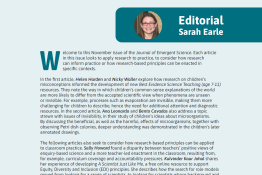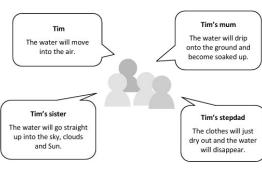Fostering critical thinking in primary science through ‘What if...’ scenarios
Issue 29 | Page 52 | Published Nov 2025
Description
Abstract
This practitioner study investigates the use of ‘What if...?’ scenarios as a strategy to promote critical thinking in Year 5 (ages 9-10) science lessons at an independent all-girls school (Reception – Year 11). The intervention was framed by enquiry and discovery learning theories (Bruner, 1960; Harrison & Howard, 2022). It drew on pedagogical strategies from ‘Thinking, Doing, Talking Science’ (TDTS), a primary science teaching approach that emphasises structured dialogue, hands-on exploration and reflective questioning as drivers of critical reasoning (Hanley et al, 2020). The findings from this study aligned with outcomes from TDTS research and indicate that ‘What if...?’ questions are a low-resource, high-impact tool for developing scientific thinking within tight curriculum timescales. Implications for practice include their scalability for teaching other science topics at Key Stage 2 (ages 7-11), alongside recommendations to explore cross-curricular opportunities. Over a six-week unit on forces and space, children engaged with weekly imaginative prompts (e.g. ‘What if gravity only worked at night?’). Responses were scored using a three-point rubric assessing predictability, reasoning and creativity. Results showed a clear progression from simple, predictable answers to diverse, well-reasoned and imaginative solutions. In addition, quieter and lower-attaining children displayed greater confidence and engagement over the six-week period.
References
Bruner, J.S. (1960) The Process of Education. Cambridge, MA: Harvard University Press
Elder, L. (2022) ‘Critical Thinking’, Routledge Encyclopaedia of Philosophy. Published online 30 May 2022. Available at: https://doi.org/10.4324/9781138609877-REE215-1. Accessed 05.09 25
Explorify https://www.stem.org.uk/explorify
Facione, P.A. (1990) Critical Thinking: A Statement of Expert Consensus for Purposes of Educational Assessment and Instruction. Executive summary uploaded December 8, 2016. Research Gate. Accessed 04.09.25
Hanley, P., Wilson, H., Holligan, B. & Elliott, L. (2020) ‘Thinking, doing, talking science: the effect on attainment and attitudes of a professional development programme to provide cognitively challenging primary science lessons’, International Journal of Science Education, 42, (15), 2554–2573
Harrison, C. & Howard, S. (2022) ‘Working with inquiry activities to encourage creative thinking’. In: Murcia, K.J., Campbell, C., Joubert, M.M. & Wilson, S. (Eds.), ‘Children’s Creative Inquiry in STEM’, Sociocultural Explorations of Science Education, 25. Cham: Springer, pps. 113–127. doi: 10.1007/978-3-030-94724-8
Kitmitto, S., González, R., Mezzanote, J. & Chen, Y. (2018) ‘Thinking, Doing, Talking Science: Evaluation Report and Executive Summary’. Education Endowment Foundation. Available at: https://educationendowmentfoundation.org.uk/projects-and-evaluation/proj...
Leonardi, S., Tazzyman, S., Spong, S. & Peck, L. (2023) Evaluation of Explorify. Interim report for STEM Learning and the Primary Science Teaching Trust. CFE Research, Leicester
Minner, D., Levy, A. & Century, J. (2010) ‘Inquiry-based science instruction–what is it and does it matter? Results from a research synthesis years 1984 to 2002’, Journal of Research in Science Teaching: The Official Journal of the National Association for Research in Science Teaching, 47, (4), 474–496
Robinson-Smith, L. et al (2025) Thinking, Doing, Talking Science (second re-grant – a two-armed, cluster randomised trial) evaluation report. University of York. Available at: Thinking, Doing, Talking Science (third trial) https://educationendowmentfoundation.org.uk
Wood, D., Bruner, J.S. & Ross, G. (1976) ‘The role of tutoring in problem solving’, Journal of Child Psychology and Psychiatry, 17, (2), 89–100
More from this issue
Abstract
The Best Evidence Science Teaching (BEST) (7-11) ‘Materials and their properties’ resources have been developed by...




